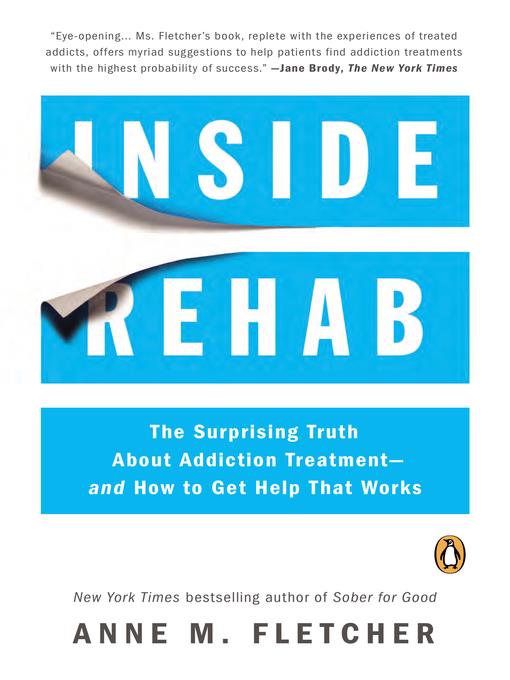
Inside Rehab
The Surprising Truth about Addiction Treatment - and How to Get Help that Works
کتاب های مرتبط
- اطلاعات
- نقد و بررسی
- دیدگاه کاربران
نقد و بررسی

Starred review from October 1, 2012
Some things never change. And as Fletcher (Sober for Good) finds in this bold report on 15 rehab facilities—from high-end, celebrity-friendly outposts to those treating people on welfare—that fact especially pertains to addiction treatment. Collecting stories from more than 100 interviews, Fletcher methodically dissects the myths about the programs that treat 2.5 million people every year. She finds, for example, that rehab isn’t necessary for recovery—some heal on their own, attend self-help groups, or see therapists; that most of the treatment in rehab programs is handled not by highly trained pros but by counselors with varying levels of education and training. She debunks myths, such as that the “12 steps” of Alcoholics Anonymous are essential for recovery. Fletcher concludes that traditional programs, such as group treatment, 12 step programs, and counseling, work for some but not for all. Dimitri, for instance, began abusing drugs at 15 and cycled in and out of programs that failed to help him. Fletcher also highlights the exorbitant cost of rehab: one young woman’s treatment drained her parents of $300,000. Fletcher presents what works, why, where to find it, and how much it costs. It’s startling, difficult, and important information for those traveling toward recovery, and anyone who wants to help.

November 1, 2012
An extensive, critical overview of modern treatment methods for substance abuse. Health and medical writer Fletcher (Weight Loss Confidential: How Teens Lose Weight and Keep It Off--and What They Wish Parents Knew, 2008, etc.) conducted interviews with patients and the administrators and staff of addiction programs, visiting more than a dozen such programs (both residential and outpatient). The author challenges the notion that an addict is powerless to overcome an addiction on his or her own or with minimal professional counseling. She found that little had changed since 2002, when her book Sober for Good was published. At that time, more than 90 percent of U.S. rehab facilities were based on the 12-step method pioneered by Alcoholics Anonymous. Today, the figure is similar, despite evidence that "the twelve-step approach isn't for everyone, and many people overcome addiction using other methods." Even patients who relapse several times are offered no alternative treatment options. Fletcher documents the many difficulties facing addicts in regard to receiving replacement medications, and among other surprising conclusions, she found little significant difference in the quality of care offered at high-end celebrity rehab centers and those at the low end of the economic spectrum. For those looking for a structured program, Fletcher includes tips on how to choose the best fit and check out facilities, including anecdotes and advice garnered from people who report having benefited from programs and others whose experiences were not positive. A valuable guide for individuals seeking help and for their families, as well as for policymakers.
COPYRIGHT(2012) Kirkus Reviews, ALL RIGHTS RESERVED.

Starred review from March 1, 2013
Best-selling author Fletcher (Thin for Life; Eating Thin for Life; Sober for Good) traverses and researches the world of addiction and substance abuse rehabilitation. In this extensively researched book, Fletcher recounts her visits to numerous outpatient and residential rehab centers, interviewing dozens of current and former patients to evaluate the nature and efficacy of the facilities and treatment models. Her travels take her to rehabs of every kind: pricey resorts, insurance-subsidized in-patient facilities, and community outpatient clinics. As she compares and contrasts different treatment modalities, her conclusions are alarming. Clearly, recovery itself is a highly individual phenomenon, with varying degrees of success resulting from many types of programs, but many readers may find it disconcerting to discover that the majority of rehab facilities lack professional counselors. Moreover, Fletcher notes that rehab directors ignore scientific evidence that substantiates effective methods for promoting recovery. Helpful checklists for clients shopping for the optimal rehab option are provided. VERDICT An excellent resource for potential patients, doctors, and addiction counselors, as well as for readers interested in a meticulously researched study that exposes the rehab industry. Readers of William C. Moyers's Now What: An Insider's Guide to Addiction and Recovery will appreciate this book. [See Prepub Alert, 9/15/12.]--Lynne Maxwell, Villanova Univ. Sch. of Law Lib., PA
Copyright 2013 Library Journal, LLC Used with permission.

Starred review from December 1, 2012
Health writer Fletcher adopts a cautious, even skeptical approach in her exploration of current treatments of substance abuse. She warns that her book is filled with disturbing accounts of seriously addicted people getting very limited care at exhaustive costs and with uncertain results. Indeed, her portrait of contemporary addiction treatment incorporates numerous stories of individuals who've undergone treatment, opinions and commentary from experts in the field, and her own visits to 15 different rehab programs. More than 13,000 addiction treatment programsoutpatient, residential, and hospital inpatientoperate in the U.S. Dropout rates and the frequency of one-year relapses are high. One expert laments, When it comes to picking a rehab, most people ask more questions before buying a vacuum. Fletcher has no such bashfulness and provides answers to fundamental questions: How much does it cost? How long does it last? What do people actually do there? She concludes that no particular treatment of substance abuse is superior to others for most individuals. Flexibilityas opposed to a one-size-fits-all approachmatters most. One authority on addiction agrees: There are as many roads to recovery as there are individuals. Inside Rehab is a valuable road map for navigating the multiple pathways and programs dealing with the problem of substance abuse.(Reprinted with permission of Booklist, copyright 2012, American Library Association.)

























دیدگاه کاربران